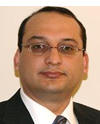DERs in Interconnected Microgrids: A Control Issue Perspective
By Afshin Izadian
Conventional interconnected microgrids have the ability to compensate for the frequency disturbances in a central control unit. However, to realize this service they require full access to all system variables over communication links. With this in mind, it is made clear that the expansion of microgrids introduces an exploding amount of data communicated to the central control unit. This issue is augmented by steep damping factor (response time) variations, since common utilities consist of a diverse blend of slow (such as steam power plants) to fast dynamic (power electronics based) generating systems. Hence, there is a need for an intelligent design of the control unit.
A first step to understanding the challenges of intelligent control unit designs is to identify the complexity of modern power systems. Recently, traditional thermal power plants, which represent slow dynamics in the frequency regulation problem, have been displaced by distributed generation from renewable sources, which tend to (re-)act much faster. Slow and fast acting control units differently influence frequency stability in power systems with high penetration of renewable energy-based power resources. Consequently, the dynamics of these resources are notably influenced by dynamics of the sources, storages and the loads. Intermittent generation of low inertia sources (e.g. power electronics-based systems) and unexpected load behavior make the process of frequency control difficult. This particular point is critical, because intermittent generation actually displaces systems that commonly offered inertia and could assist deterministically in such ancillary services. In addition, microgrid systems exhibit several interconnected and shared dynamics and rely on large number of sensors and Phase Measurement Units to operate reliably. Once the signals are measured, limited bandwidth of control system and limited capacity of power delivery causes serious incapability in emulating enough inertia from the power electronic-based energy sources. Introduction of power electronics-based responsive loads with adjustable power levels causes additional de-stabilizing effects that may affect system’s frequency and or voltage. High bandwidth controllers with an adequate design are required to stabilize these systems. While coherent response to the rest of the traditional system is desirable, the reduced inertia of fast dynamic energy sources raises serious control system limitations. In addition, estimation of load shedding conditions is purely based on bands of frequency to curtail loads voluntarily or involuntarily. It should be noted however, that load shedding represents a last-resort solution when it comes to frequency stability.
Several control techniques have been proposed to emulate inertia in wind power among which a few suggest modification of torque control to reflect inertia, while others propose the use of the kinetic energy stored in the wind turbine to, thus, emulate synchronous machine inertia response. Inertia emulation has been practically applied through proper tuning of the corresponding control topology, so that the stress on the turbine shaft may be limited. However, these control units are not adaptive to the various types of contingencies that cause frequency excursions. Furthermore, traditional droop control generates a large stress on the shaft of wind turbine, as the pitch angle controllers must displace a huge mass of blades. Limited bandwidth control of modern sources adds to the response behavior and further limits the frequency control.
More precisely, traditional power system controllers and stabilizers depend on large momentum of slow dynamics of generation units to sense the system behavior and settle to a new stable operating point. Low bandwidth controllers rely on large system inertia to damp frequency oscillations. However, as renewable energy-based generation units become dominant, these controllers experience a mix of fast and slow dynamics, which needs to be adjusted accordingly. A single controller with a pre-determined bandwidth might not be able to adjust the gains to accommodate a wide range of operating points in a mix of slow and fast dynamics. One possible solution may require treating the system in a decentralized platform and accurately tuning high-bandwidth estimators and controllers based on the contingency events. The challenge is to distinguish contingencies and generate suitable control actions that involves controllable loads, distributed energy resources or a combination of both.
Contributors

Afshin Izadian, IEEE Senior Member, is an associate professor at the Purdue School of Engineering and Technology, Indianapolis. He is the founding director of the Energy Systems and Power Electronics Laboratory (ESPEL) at IUPUI. He is a lifetime member of Etta Kappa Nu (HKN), Tau Beta Pi (TBP) and Sigma Xi. He received his MS in Electrical Engineering from Iran University of Science and Technology in 2002, and his PhD in Electrical Engineering from West Virginia University in 2008. He was a postdoctoral researcher at University of California Los Angeles in 2009.
To have the Bulletin delivered monthly to your inbox, join the IEEE Smart Grid Community.
Past Issues
To view archived articles, and issues, which deliver rich insight into the forces shaping the future of the smart grid. Older Bulletins (formerly eNewsletter) can be found here. To download full issues, visit the publications section of the IEEE Smart Grid Resource Center.




